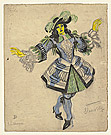Les Tentations de la Bergère [Temptations of the Shepherdess]
Ballet in one act
- Producer: Les Ballets Russes de Serge Diaghilev
- Premiere: 3 January 1924, Théâtre de Monte Carlo, Monaco
- Costume design: Juan Gris
- Costumier: possibly Marie Muelle
- Scenery design: Juan Gris
- Music: Michel de Montéclair, arranged by Henri Casadesus
- Choreography: Bronislava Nijinska
- Main characters: Shepherdess, Shepherd, Marquis, counts, Countesses, King
A shepherdess is courted by a lord. However, she prefers the attentions of the local shepherd to the nobleman. The ballet ends with the king agreeing to the Shepherdess and Shepherd’s marriage union.
Les Tentations de la bergère, developed from an earlier interest by Diaghilev and the miriskusniki circle in the neoclassical and Renaissance music that was popular in Russia during the 1890s and early 1900s, particularly the dance of Michel Pignolet de Montéclair (1667–1737) which had been rearranged as Les Plaisirs champêtres by Henri Casadesus (1897–1947) for his Society of Ancient Instruments.7 After hearing it, Benois proposed it as a ballet. The young Stravinsky also was impressed with the ‘bucolic pleasures’ of the music, and the interest shown by these two men may have persuaded Diaghilev to develop it, with Gris, into a ballet in 1924, along with the similarly eighteenth-century themed Ballet de l’Astuce féminine / Cimarosiana of the same season. The National Gallery’s costume for the Countess from this production, with its splendid appliquéd regal fleur-de-lys design, may have been used for one of Diaghilev’s private Fêtes Mervilleuses held in the Hall of Mirrors at the Palace of Versailles in 1923.





